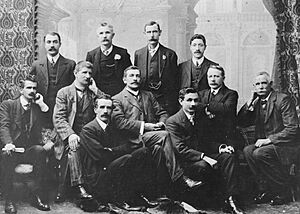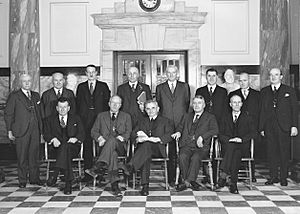Michael Joseph Savage facts for kids
Quick facts for kids
Michael Joseph Savage
|
|||||||||||||||||||||
|---|---|---|---|---|---|---|---|---|---|---|---|---|---|---|---|---|---|---|---|---|---|
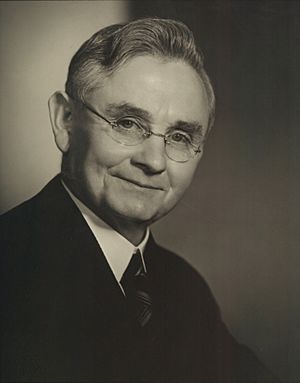
Iconic portrait of Savage, 1935
|
|||||||||||||||||||||
| 23rd Prime Minister of New Zealand | |||||||||||||||||||||
| In office 6 December 1935 – 27 March 1940 |
|||||||||||||||||||||
| Monarch | George V Edward VIII George VI |
||||||||||||||||||||
| Governor-General | George Monckton-Arundell | ||||||||||||||||||||
| Preceded by | George Forbes | ||||||||||||||||||||
| Succeeded by | Peter Fraser | ||||||||||||||||||||
|
|||||||||||||||||||||
| Member of the New Zealand Parliament for Auckland West |
|||||||||||||||||||||
| In office 17 December 1919 – 27 March 1940 |
|||||||||||||||||||||
| Preceded by | Charles Poole | ||||||||||||||||||||
| Succeeded by | Peter Carr | ||||||||||||||||||||
| Personal details | |||||||||||||||||||||
| Born |
Michael Savage
23 March 1872 Tatong, Victoria, Australia |
||||||||||||||||||||
| Died | 27 March 1940 (aged 68) Wellington, New Zealand |
||||||||||||||||||||
| Resting place | Bastion Point, Waitematā Harbour, Auckland | ||||||||||||||||||||
| Political party | Labour (1916–40) Social Democratic (1913–16) Socialist (1907–13) |
||||||||||||||||||||
| Profession | Trade unionist politician |
||||||||||||||||||||
| Signature |  |
||||||||||||||||||||
Michael Joseph Savage (23 March 1872 – 27 March 1940) was a very important New Zealand politician. He served as the 23rd Prime Minister of New Zealand. He led the First Labour Government from 1935 until he passed away in 1940.
Savage was born in Australia and moved to New Zealand in 1907. He worked hard and became a trade unionist, which means he helped workers get fair treatment. In 1910, he became the president of the Auckland Trades and Labour Council. He was a big supporter of the New Zealand Labour Party when it started in 1916.
He became a Member of Parliament in 1919. Later, in 1933, he was chosen as the Labour Party Leader. Savage led the Labour Party to win the election in 1935 for the first time ever. People really liked his plans for economic recovery and social welfare.
His popularity helped the Labour Party win even more votes in 1938. His government joined Britain in declaring war against Germany in 1939. Savage's health got worse after the 1938 election, and he died while still in office. Peter Fraser took over as Prime Minister after him.
Many people see Savage as the person who created New Zealand's welfare state. This means he helped set up systems to support people, like healthcare and pensions. He is often seen as one of New Zealand's greatest prime ministers. He was the only New Zealand prime minister to serve under three different kings: George V, Edward VIII, and George VI.
Contents
Early Life and Moving to New Zealand
Michael Savage was born in Tatong, Australia, in 1872. He was the youngest of eight children. His parents were Irish immigrants who came to Australia to escape the Irish Famine. His mother passed away when he was five, so his sister Rose helped raise him.
From age 14, Savage worked in a shop and took evening classes. He was strong and enjoyed boxing and weightlifting. In 1891, his sister Rose and brother Joe died, which was very sad for him. After this, he started using his brother's name and became known as Michael Joseph Savage.
After losing his job in 1893, Savage moved to New South Wales. He worked as a labourer and joined a workers' union. He learned about new political ideas that later influenced his plans for New Zealand.
In 1907, Savage moved to New Zealand. He arrived in Wellington on Labour Day, which is a holiday for workers. He worked in different jobs, like a miner and a storeman. Soon, he became very involved in the union movement, helping workers. He settled in Auckland in 1908 and lived with the French family for many years.
Michael Savage's Political Journey
At first, Michael Savage didn't think the first New Zealand Labour Party was socialist enough. Instead, he became the leader of the "Red Feds," a group of unions. He helped organize meetings and shared their socialist newspaper.
Early Political Efforts
Savage tried to become a Member of Parliament in 1911 and 1914 for Auckland Central. He didn't win, but he came in second place both times. During this time, he was also active in local unions. He became president of the Auckland Trades and Labour Council.
During World War I, Savage was against conscription, which is forcing people to join the army. He believed that wealth should be shared before people were forced to fight. However, he did join a training camp in 1918 when he was called up.
In 1916, Savage strongly supported forming a united New Zealand Labour Party. He became its national vice-president in 1918. In 1919, he was elected to the Auckland City Council. He served on the council until 1935.
Becoming a Member of Parliament
In the 1919 New Zealand general election, Savage was elected to Parliament for the Auckland West area. He kept this seat until he died. He became one of eight Labour Members of Parliament. After the 1922 election, he became the Labour Party's deputy leader.
Throughout the 1920s, Savage worked to get more support for the Labour Party. He traveled to rural areas and spoke about increasing pensions and providing free healthcare for everyone. He helped create the Family Allowances Act in 1926, which provided support for families.
In 1927, Savage helped change the Labour Party's land policy. This change helped the party gain more support from people in rural areas. When the Labour leader, Harry Holland, died suddenly in 1933, Savage became the third leader of the Labour Party.
Savage also helped create an alliance between the Labour Party and the Rātana Church. This church had many Māori followers. The Labour Party worked with Rātana followers on Māori policies. This partnership was made official in 1936.
In 1935, Savage received the King George V Silver Jubilee Medal.
Michael Savage as Prime Minister
During the Great Depression, a time of great economic hardship, Savage traveled around the country. He became a very well-known and respected figure. He was a great speaker and led the Labour Party to win the 1935 New Zealand general election. As Prime Minister, he also took on the roles of Minister of External Affairs and Minister of Native Affairs.
In 1937, Savage traveled to Britain to attend the coronation of King George VI. While there, he spoke out against Britain for not doing enough to support the League of Nations. He also argued that New Zealand and other countries in the Commonwealth were not properly included in decisions about foreign policy and defense.
Savage's government was quick to criticize Germany's rearmament and Japan's expansion. He also spoke against Italy's conquest of Abyssinia. At a conference, Savage criticized Britain's policy of appeasement, which meant trying to avoid war by giving in to demands. He said, "You can pay too high a price even for peace."
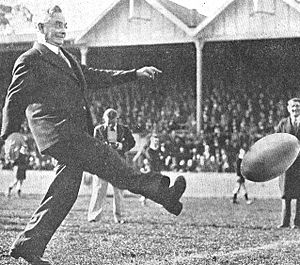
In 1938, Savage and his Finance Minister, Walter Nash, started planning Labour's social security proposals. These plans were based on their promises from the 1935 election. Savage began to use the term "applied Christianity" to describe the government's plan.
The Social Security Bill was a big step. It included:
- Money for people aged 16 and over who were unemployed.
- A free healthcare system, including doctors, hospitals, and maternity care.
- A pension for men and women aged 60 and over.
- A universal superannuation for everyone aged 65 and over.
Savage was key in making this plan happen. He helped solve disagreements within the Labour Party and responded to concerns from others. He insisted that the Act would not start until April 1, 1939. This gave the opposition party a chance to stop it if they won the 1938 election. However, the Labour Government was very popular and easily won the 1938 New Zealand general election. The Social Security Act was passed, creating the first social security system in the Western world.
After the 1938 election, there was some disagreement within the Labour Party. John A. Lee, a Labour member, was unhappy and criticized Savage's leadership. This led to Lee being removed from the party.
Second World War
Savage led New Zealand into the Second World War. New Zealand officially declared war on Nazi Germany on September 3, 1939, just hours after Britain. New Zealand did this to show its loyalty to Britain. Savage famously declared from his sick bed:
"With gratitude for the past and confidence in the future we range ourselves without fear beside Britain. Where she goes, we go; where she stands, we stand. We are only a small and young nation, but we march with a union of hearts and souls to a common destiny."
Death and Remembering Michael Savage
Savage had cancer during the 1938 election. He delayed getting treatment so he could focus on the election campaign. He passed away from cancer on March 27, 1940.
Michael Joseph Savage was very passionate about his political beliefs. Because of his strong beliefs and his death while in office, he became a hero for many people. His welfare policies were highly praised. It is said that his picture hung in many Labour supporters' homes. He was so popular that he reportedly told John A. Lee, "They [the people] think I am God" after Labour won the 1938 election.
His state funeral was a very big event. His body was taken by train from Wellington to Auckland, with many stops along the way. People gathered to pay their respects. He was first buried temporarily, then moved to St Patrick's Cathedral. Later, a special memorial was built for him.
Savage is buried at Bastion Point in Auckland. His burial place is called the Savage Memorial. It is a large mausoleum with a tall tower, a memorial garden, and a reflecting pool.
Michael Savage's Legacy
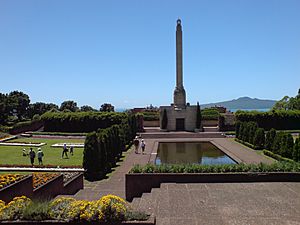
Michael Joseph Savage is remembered as the person who created New Zealand's welfare state. His Labour government laid the groundwork for a system where everyone would have jobs and a strong system of social services.
Historians and experts believe he was one of New Zealand's greatest and most respected Prime Ministers. He was often called "Everybody's Uncle" because of his kind and friendly personality. His ability to speak well helped people accept his government's new policies. To show how much he believed in his government's plans, Savage even personally helped a family move their furniture into one of the first government-built state houses.
The famous 1935 portrait of Savage was displayed in many New Zealand homes. Even today, Prime Minister Jacinda Ardern has a framed copy in her office. In 2020, the original photo negative was found in the Te Papa museum's collections.
Savage was also a patron of the New Zealand Rugby League. In 1999, The New Zealand Herald newspaper named him "New Zealander of the Century."
See also
 In Spanish: Michael Joseph Savage para niños
In Spanish: Michael Joseph Savage para niños


